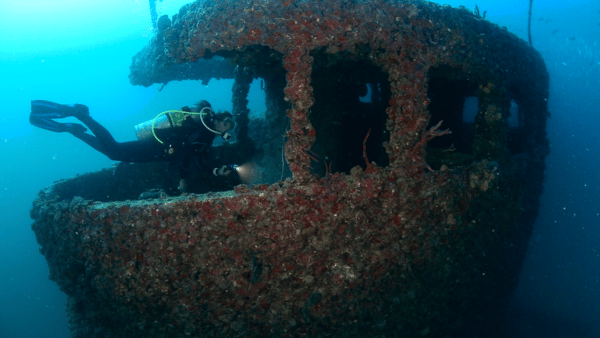Why The Florida Keys Are Perfect For New Divers
Scuba diving unlocks a new world, one that offers amazing adventures and underwater encounters with some of the world's most incredible marine species. Exploring beautiful coral reefs full of candy-colored sea fans, schools of exotic fish and friendly creatures. Swimming face-to-face with a sea turtle or saying hello to a stingray hiding in the sand — you can do all of this and more in the Florida Keys and Key West. The Florida Keys are located just 50 miles south of Miami and offer incredible dive experiences for scuba divers of all skill levels: Giant stride into your first underwater experience as a newly certified diver in this reef mecca. Scuba divers with more experience can become wreck trekkers and explore 12 amazing shipwrecks dotting the isles.
Start your scuba diving road trip in Key Largo and head south, counting the mile markers (MM) — and racking up adventures — as you go.
Key Largo
Known as the "Dive Capital of the World," Key Largo is home to John Pennekamp Coral Reef State Park, which is the first underwater preserve established in the United States. The island is also home to more than 70 underwater sites for scuba diving and snorkeling. Iconic Key Largo dives include the 9-foot Christ of the Abyss statue, which sits in 25 feet of water and rises just below the surface, and Molasses Reef, which is blanketed in coral heads and massive schools of fish. The must-dive wreck for beginners is the S.S. Benwood. This World War II shipwreck rests at a max depth of 35 feet and is full of marine life.
But the ship that will have you expanding your certifications is the 510-foot Spiegel Grove. At nearly two football fields long, it's the Mount Everest of underwater sites and sits at a max depth of 140 feet. With so much to explore, you'll need a half-dozen dives or more to see it all.
Islamorada
Islamorada is home to a variety of shallow reefs, walls and wrecks ready to be explored. Start with Alligator Reef in just 25 feet of water. It's marked by a 136-foot tall lighthouse and is vibrant, lush and home to 189 identified species of fish, making for one epic shallow dive. Fin through Davis Reef for a chance to spot the resident green morays or Pickles Reef to photo flamingo tongue cowries. Step-up the excitement on Crocker Wall: this expansive reef is famous for its 30-foot coral-encrusted decline. Be sure to off-gas with key lime pie (no trip is complete without a taste!) and live music at Sharkey's Pub or watch the sunset at Lazy Days.
Marathon
As you make your way south to Marathon, dive Sombrero Key and Coffin's Patch, two no-take zones in the 2,900-square-nautical-miles protected by the Florida Keys National Marine Sanctuary. Coral canyons and pillars provide shelter for schools of grunts, snapper, lobster and curious barracuda. Depths in the sanctuary range from 3 feet for snorkelers to more than 100 feet for experienced divers. One of those dives is the queen of the Marathon shipwreck fleet, the endlessly fascinating, Thunderbolt. It was intentionally sunk in 1986 to form an artificial reef and is packed with big animals, including 700-plus-pound goliath grouper.
After diving in Marathon Key, slide into your flip-flops and head to one of the many mom-and-pop restaurants, like Castaway Waterfront Restaurant & Sushi Bar, Plaza Grill or Herbies for conch fritters and fish tacos. Looking for a quick bite before an early morning dive? The Wooden Spoon serves a great breakfast everyday starting at 5:30 a.m.
The Lower Keys
Escape the hustle and bustle for a quieter lifestyle in the Lower Keys. Fishing flats, lush mangroves and wetlands are home to Key deer who dictate a strict nighttime speed limit of 35 mph. Life slows for the perfect backcountry getaway, and an even more perfect dive at Looe Key Reef. Marked by 70 buoys, Looe Key is home to more varieties of marine life than anywhere else in the Keys. Depths range from 15 feet, where most large coral formations are found, to 105 feet where sponges and soft corals thrive. Topside, Bahia Honda State Park is Florida's southernmost state park offering some of the Keys' best snorkeling. Step onto a preserved portion of the Bahia Honda Bridge — built by Henry Flagler in 1905 as a rail system connecting the upper keys to Key West — to see panoramic views of the islands. The bridge was destroyed by a Hurricane in 1935, but remains remarkably intact.
Key West
Key West is your last stop in the Florida Keys, and the liveliest of all islands. The performers on Mallory Square are wonderfully welcoming, and the nightlife never stops at hotspots like Sloppy Joe's and Hog's Breath Saloon. Underwater, the sites are plentiful. Sand Key, Ten-Fathom Ledge and Nine Foot Stake are ideal for beginners. These shallow coral gardens are packed with dramatic overhangs, schooling colorful fish and a multitude of life. Nearby, discover decades of Martime history on shipwrecks like Joe's Tug — resting at 65 feet, it's perfect for close encounters with goliath grouper — the Cayman Salvor at 80 feet, and the massive General Hoyt S. Vandenberg at 100 feet. Fondly known as the Vandy, this 522-foot ship is the second largest artificial reef in the world and an advanced diver's dream.
No matter what adventures you seek, travel along the 107-mile-long Overseas Highway through the Florida Keys and you'll find lots to do both above the water and below. For more information on scuba diving, snorkeling and tourism information on the Florida Keys, go to fla-keys.com/diving.
